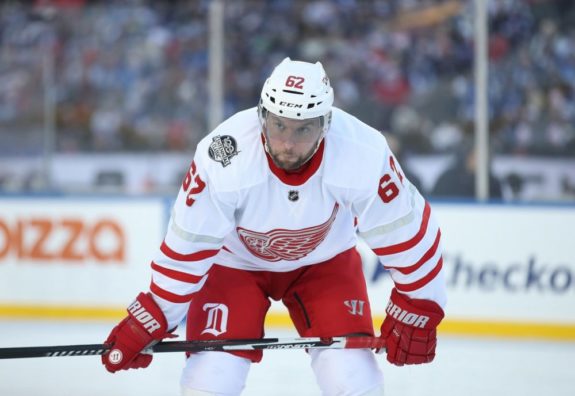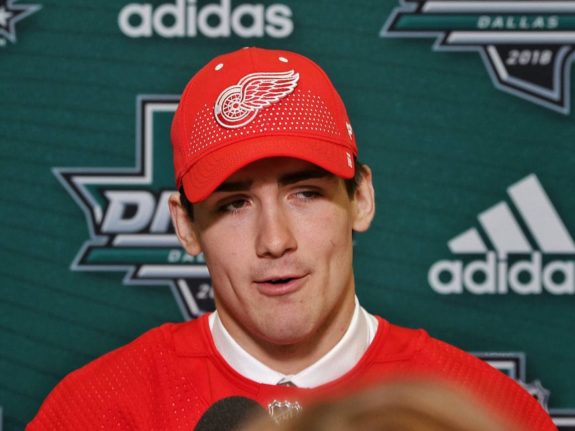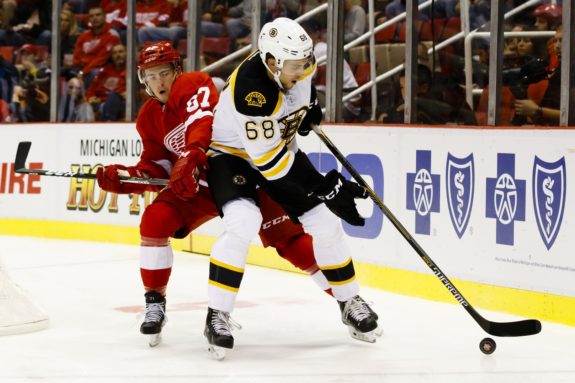For the Detroit Red Wings, the appropriate time to “play the kids” is an age-old debate, with fans, media, and management each having varied opinions on the matter.
But as Bob Dylan said about the times, they are a-changin’. Sort of.
During Detroit’s end-of-season press conference, general manager Ken Holland stated that he expects two or more Red Wings prospects to push for NHL jobs in the fall.
Michael Rasmussen and Filip Hronek’s strong campaigns plus the draft-day acquisition of Filip Zadina gave fans some confidence that Holland’s promise would come to fruition. The later signings of Mike Green and Thomas Vanek did not, though.

In order for these prospects to play, they’ll need to take jobs from veterans – Holland made it quite clear that there would be no handouts. The “they took our jobs” versus “they are given jobs” difference may not ease tensions, but it’s ultimately the right approach to prospect development.
But when is the future ready to take present jobs? From an offensive standpoint, it appears that time is relatively soon.
Expected Production of Red Wings Prospects
Earlier this month, Corsica Hockey’s Emmanuel Perry released his NHLe (NHL equivalency) model to compare and translate players’ production in different leagues. An in-depth explanation of the “fancy stat” can be found here. In the meantime, NHLe basically breaks down to:
A player scored X points in a non-NHL league. How many points would that convert to if he played 82 NHL games that season instead?
It’s not a guarantee of NHL production – think of NHLe as the hockey version of exchanging U.S. Dollars for Euros at the bank or airport.
Perry’s NHLe is not adjusted for strength or role, and is the raw conversion from one league to another. It’s not a perfect translation, but an interesting exercise nonetheless.

With this information, we can convert Detroit’s prospects’ points from their respective leagues to see how they would perform if they spent the 2017-18 season in the NHL. For this analysis, we’ll look at the forwards and defensemen from Detroit’s Top 25 Prospects Ranking.
Red Wings Forward Prospects
| Player | League | PPG | Conversion | NHLe (Points) |
| David Pope | NCAA | 1.17 | 0.17 | 16.44 |
| Dominic Turgeon | AHL | 0.46 | 0.42 | 16.13 |
| Michael Rasmussen | WHL | 1.26 | 0.15 | 15.95 |
| Filip Zadina | QMJHL | 1.44 | 0.13 | 15.72 |
| Evgeny Svechnikov | AHL | 0.40 | 0.42 | 14.03 |
| Jonatan Berggren | SuperElit | 1.50 | 0.11 | 13.74 |
| Joe Veleno | QMJHL | 1.23 | 0.13 | 13.49 |
| Givani Smith | OHL | 0.65 | 0.16 | 8.43 |
| Zach Gallant | OHL | 0.57 | 0.16 | 7.42 |
| Lane Zablocki | WHL | 0.48 | 0.15 | 6.06 |
| Ryan O’Reilly | USHL | 0.76 | 0.08 | 5.04 |
Using just the data above, no players’ NHLe would have surpassed the points-per-game rate of any Red Wings forward from the 2017-18 season. Don’t take this data literally, though – if Zadina and Rasmussen make the big squad next year and play a full season’s worth of games, you can expect them to score more than listed above.
It was interesting to see David Pope and Dominic Turgeon at the top. Those two players project to be bottom-six forwards, while Zadina and Rasmussen would be featured in the top-six. However, Pope and Turgeon have had a lot more time to develop than the others and played in stronger leagues.
Red Wings Defense Prospects
| Player | League | PPG | Conversion | NHLe (Points) |
| Libor Sulak | SM-liiga | 0.76 | 0.47 | 29.34 |
| Filip Hronek | AHL | 0.58 | 0.42 | 20.24 |
| Dennis Cholowski | WHL | 0.96 | 0.15 | 12.15 |
| Vili Saarijarvi | AHL | 0.26 | 0.42 | 9.11 |
| Gustav Lindstrom | Allsvenskan | 0.36 | 0.28 | 8.39 |
| Jared McIsaac | QMJHL | 0.72 | 0.13 | 7.90 |
| Joe Hicketts | AHL | 0.18 | 0.42 | 6.23 |
| Alec Regula | OHL | 0.37 | 0.16 | 4.83 |
| Seth Barton | BCHL | 0.67 | 0.07 | 3.62 |
| Kasper Kotkansalo | NCAA | 0.15 | 0.17 | 2.11 |
Right away, Libor Sulak and Filip Hronek jump off the chart with high amounts of translated points – for Detroit’s sake at least. For an organization without much firepower on the blue line, these two represent serious upgrades. Let’s see how they stack up with Hockeytown’s blueliners, using the same points per game and conversion method. (NHLe conversion rate for the NHL is 1.00 for those keeping score at home.)
Back to the pile of data we go:
| Player | League | PPG | Conversion | NHLe (Points) |
| Mike Green | NHL | 0.50 | 1.00 | 41.00 |
| Libor Sulak | SM-liiga | 0.76 | 0.47 | 29.34 |
| Niklas Kronwall | NHL | 0.34 | 1.00 | 28.03 |
| Filip Hronek | AHL | 0.58 | 0.42 | 20.24 |
| Trevor Daley | NHL | 0.21 | 1.00 | 17.04 |
| Nick Jensen | NHL | 0.19 | 1.00 | 15.19 |
| Danny DeKeyser | NHL | 0.18 | 1.00 | 15.14 |
| Jonathan Ericsson | NHL | 0.16 | 1.00 | 13.16 |
| Xavier Ouellet | NHL | 0.16 | 1.00 | 12.76 |
Even when Detroit’s NHL blueliners have their point-per-game production spread out over 82 games, it still does not look good for the veterans. Based on the findings of NHLe, Sulak and Hronek appear to have the capability to out-produce mainstays Trevor Daley, Nick Jensen, Danny DeKeyser, and Jonathan Ericsson at the NHL level.
And while this stat factors in offense only, there’s an argument to be made about similar, if not better, play in the defensive zone from Hronek and Sulak considering how last year went for the Red Wings.
Final Word
As I mentioned above, NHLe is not perfect, but still noteworthy. When you consider Hronek and Sulak’s suggested NHL production, it makes you wonder whether the Daley signing was needed. The same goes for DeKeyser and Ericsson.

It’s also interesting to see the projections for Evgeny Svechnikov and Joe Hicketts, who struggled in the AHL but produced above their NHLe in a small sample size of NHL games last season.
While it may not be a given to see a bunch of new faces on the Red Wings next season, those changes are coming. Prospects like Zadina, Rasmussen, Hronek, Joe Veleno, Dennis Cholowski, and Jonatan Berggren will be in the NHL soon enough as Detroit transitions into its new identity. A handful are already capable of stepping into an NHL role.
*Stats courtesy of Elite Prospects and methodology courtesy of Emmanuel Perry of Corsica Hockey.